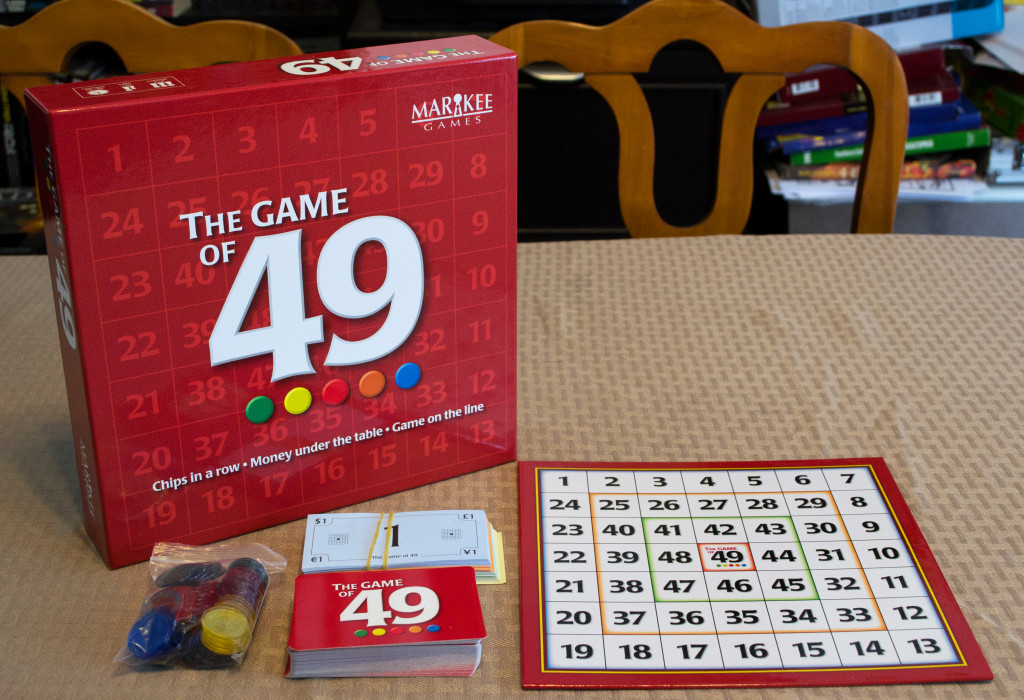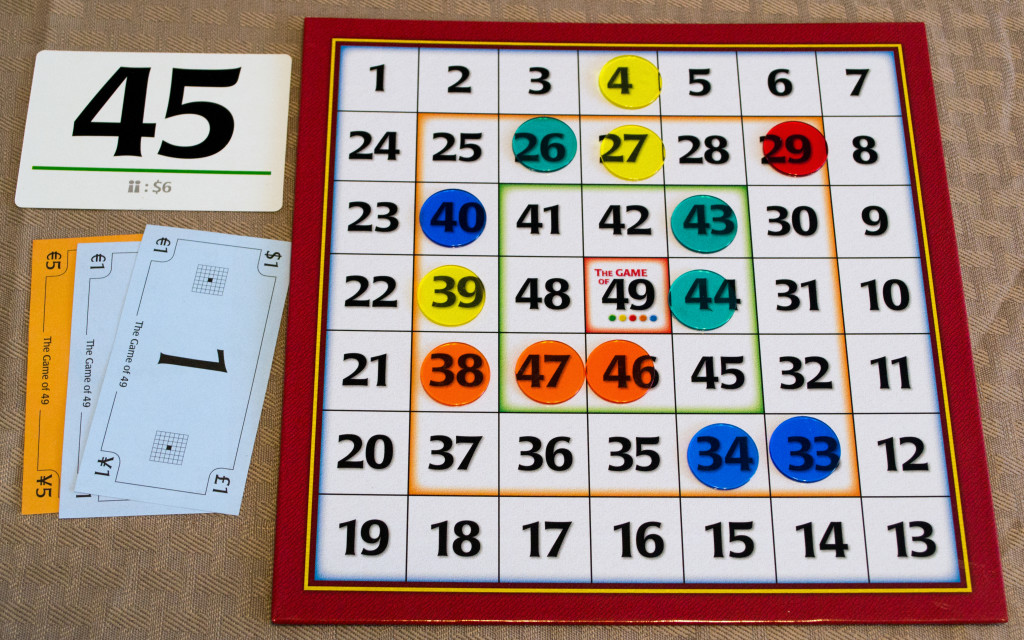Like the idea of “Acquire” but find it too complicated for either yourself or your gaming group? “The Game of 49” might be a bit more your speed. In short, it’s an auction game that tasks players with getting four chips of their color in a row on a 7×7 grid…doing so earns them victory. I suppose one could compare it to “Bingo”, but with auctioning instead of random number calling. Further, players will be able to earn back the money they’re spending from time to time, though the amount they earn is often dependent on how many tokens they have out at the time. Before I go any further, I’d like to thank Game Designer & Publisher Mark Corsey for reaching out and providing me with a free prototype copy for review purposes.
Components
The game includes: One game board (a 7×7 grid numbered 1-49), 60 number cards, a card tray, chips in 5 colors (15 each), paper money ($1s, $5s, $10s, $20s), a money tray, and an instruction booklet.
Setup & Gameplay
The board is placed in the center of the table within easy reach of all players. The number cards are shuffled and placed face down in the card tray. Each player gets a set of chips of one color along with $49 in bills (it’s recommended that one player be the banker to facilitate monetary transactions). Someone is then chosen to be the starting player, who receives the card tray.
The game is played out over a series of turns. The active player (or the player with the card tray) opens the turn by drawing the top card and displaying it for all to see. The active player then either starts an auction for the card (buy bidding $1 or more) or passes. In clockwise order, players will attempt to either outbid the previous bid or pass. This continues until one player wins the auction (and thus the card)…though if all players pass from the start without bidding anything, the card is simply removed from play.
When a player wins a card, they’ll place a token on the corresponding number on the grid. However, there are a few “wild/payoff” cards that not only allow players to place a single chip on any of the numbers listed, but also pay money to players based on how many chips they have on the board. Players receive $7 for each chip they have on the board up to a maximum of $49. The rules are slightly different for a two player game, with players earning less money for having eight chips or more on the board. The “ii” symbol near the bottom left of these cards indicates the minimum bid required in order to acquire the card, though this minimum bid rule is optional.
At the end of a turn, the card tray is passed clockwise. Turns continue until someone gets four chips in a row…whoever does, wins the game! In the event that the deck is exhausted before this happens, whoever has the most chips on the board wins, followed by whoever has the most money, followed by whoever has a chip on the highest numbered space.
Editor’s Note: The above doesn’t cover all of the rules found in the manual, but should give you an idea as to how the game is played.
The Review
I’ve come to realize that “The Game of 49” is deceptively simple. While the goal itself can be defined in a single sentence, there’s a risk/reward system in play that’ll make players think twice about how much they’re bidding at any particular time. Sure, it may sound like a great idea to bid high and place as many tokens as you can early on…but what if those payoff cards come up later rather than sooner? You may find yourself out of money to bid on the spaces that could have won you the game. “Acquire” challenged players in this way as well…that is, mismanagement of your money in the early onset could leave you trailing behind everyone else. Luckily (for casual players mostly), “The Game of 49” is a bit more forgiving and random than “Acquire”.
Speaking of random, players are admittedly at the mercy of the number deck. With that said, players will have a chance to strategize a bit when those wild cards come up. Having more than one number to choose from really heightens the tension, especially since you know that money will pay out right after someone wins the card and places a chip. This might encourage players to be a bit more generous with their money during the auction phase than usual. There’s also the whole calculating odds bit in that if you’re good at counting cards, you can get a good feel of what has yet to draw and what your chances are of getting another payoff in the short-term.
There’s very little not to like about “The Game of 49”. The manual and its concepts are easy to understand, making it an ideal game to play on family game night. My only complaint was with the quality of the components and the listed retail cost of $25 (plus shipping and handling). Games like “Sequence” that sell for about $15-$20 feature thick poker chips of fairly good quality…”The Game of 49″ offers transparent colored counting chips that are small and light. For $25 I expected a bit more from the components…either that, or the asking price should be $5-$10 lower. It’s important to note that everyone has different feelings on what something should ACTUALLY cost, so take my opinion with a grain of salt. There’s also the fact that some developers/publishers are able to mass produce games at lower prices, but as a consumer writing reviews for consumers, I have to think in terms of a consumer regardless of what goes on behind the scenes.
All in all though, I believe you’ll find “The Game of 49” to be a solid choice when confronted with the question of: “What game should I introduce to the family tonight?”
Final Verdict: 8/10
—
You can learn more about and purchase “The Game of 49” by visiting the official website, here:
—


